|
|
|
Sort Order |
|
|
|
Items / Page
|
|
|
|
|
|
|
| Srl | Item |
| 1 |
ID:
180657


|
|
|
|
|
| Summary/Abstract |
In the study of terrorism, assassinations and suicide bombings have most commonly been considered as distinct phenomena. In practice, however, Al-Shabaab has shown a proclivity to use suicide bombings precisely as a means of assassination. But just how unique – if at all – is its use of suicide bombing assassinations (SBAs)? Using three unique databases on African suicide bombing combined with data from the Global Terrorism Database, this article seeks to understand the degree of uniqueness of Al-Shabaab’s SBA efforts from 2006 to 2020. In comparing Al-Shabaab to its nearest analogues – Boko Haram and Al-Qaeda in the Islamic Maghreb (AQIM) – across five different SBA metrics, this article demonstrates how Al-Shabaab is indeed rightly considered to be unique in its tendency to use suicide bombings as a tool for assassinations, at least on the African continent. It concludes by considering just what rationales underlie this proclivity, focusing on group-specific and environmental factors.
|
|
|
|
|
|
|
|
|
|
|
|
|
|
|
|
| 2 |
ID:
066496


|
|
|
| 3 |
ID:
168220


|
|
|
|
|
| Summary/Abstract |
In recent years, an upward trend in terrorist attacks has mirrored an increase in suicide attacks. According to our preliminary analysis, the events of September 11th marked a sea change in the number of terrorist attacks. While a rich literature has evaluated why terrorists participate in suicide attacks, none have considered the uptick in volume after 9/11, and fewer yet have considered how female fighters may be contributing to this. We evaluate how both structural and female-specific factors affect the likelihood of female fighter suicide attacks. Recent literature discovered a trend in terrorist groups using females as suicide bombers due to cultural norms that permit them to get closer to targets. We test our theory using data from the Chicago Project on Security and Threats Suicide Attack Database (CPOST-SAD) and various datasets from the Quality of Government (QOG) compendium for the 1986–2016 time period. We construct a series of models that consider both female-specific and structural factors that could explain variation in the number of female suicide attacks. Our results indicate that our models encompass relatively stable patterns. Female political empowerment, female educational attainment, and female employment rates are significant and positive in our post-9/11 models, indicating that they may increase female suicide attacks. Democracy is a relevant structural factor and generally yields a positive effect on female suicide attacks across both time periods and multiple models. Ethnic fractionalization is significant in both time periods but yields a negative effect before 9/11 and a positive effect in the later period.
|
|
|
|
|
|
|
|
|
|
|
|
|
|
|
|
| 4 |
ID:
105000


|
|
|
|
|
| Publication |
2011.
|
| Summary/Abstract |
his research on suicide terrorism and arms control focuses on use of the human body as a weapon and the intersection of the body with technology. Through the case of the French terrorist group Action directe (Direct Action) the article analyzes the impact of suicide terrorism on conventional terrorists, the possibility that conventional terrorists become more violent when another group with similar or identical goals turns to suicide terrorism, and asks whether conventional terrorists turn to suicide terrorism once an example is set by another group. The article concludes that contemporary suicide fosters a perception of strength and of the vulnerability of conventional forces. In this light, suicide terrorism and the role that the body plays with an exploding prosthetic, are a major new challenge to how arms control is analyzed and discussed.
|
|
|
|
|
|
|
|
|
|
|
|
|
|
|
|
| 5 |
ID:
068587
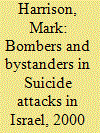

|
|
|
| 6 |
ID:
188031


|
|
|
|
|
| Summary/Abstract |
Globally, the spread and use of suicide bombing attacks have become a regular occurrence. Suicide terrorism literature focuses primarily on conventional suicide bombing attacks. However, a growing trend has been observed in the adoption of complex suicide attacks. Using Al-Shabaab as a case study, this paper investigates the phenomenon of complex suicide attacks. We explore the tactical differences of complex suicide attacks vis-à-vis simple attacks in terms of its target goal, discriminative lethality, and delivery method. The paper relies on a uniquely constructed dataset of the group’s suicide operations, employing a variety of data collection techniques. The findings reveal that, inter alia, complex suicide attacks reduce civilian casualties compared to simple suicide attacks. Contrary to the group’s intent and official guidelines to target foreign entities; findings illustrate that domestic targets bear the brunt of most complex suicide attacks. These findings have the potential to contribute to counter-terrorism strategies and be adopted by concerned states in order to effectively protect significant loss of lives and destruction of property resulting from suicide terrorism.
|
|
|
|
|
|
|
|
|
|
|
|
|
|
|
|
| 7 |
ID:
067777
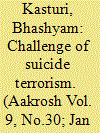

|
|
|
|
|
| Publication |
2006.
|
| Summary/Abstract |
Terrorism is today a global scourge and nations have to face the challenge in the best manner that they can within the framework of their political and legal systems. But, when terrorist groups hijack passenger airplanes and smash them into targets like the World Trade Centre in New York, killing themselves and thousands of others in the process, only then the world’s preeminent power the . ...
|
|
|
|
|
|
|
|
|
|
|
|
|
|
|
|
| 8 |
ID:
080340


|
|
|
|
|
| Publication |
2007.
|
| Summary/Abstract |
U.S. military commanders and others in the defense community are concerned that militant Chechens, trained in suicide bombing and extremist tactics, are available to support Taliban elements in Afghanistan today. In reality, the relationship between these two groups is minimal and there is little likelihood of substantive cooperation between them. This position becomes clear after a brief review of Chechnya's history regarding Islam, its extremist groups, and its chronology of suicide bombings.
|
|
|
|
|
|
|
|
|
|
|
|
|
|
|
|
| 9 |
ID:
169918


|
|
|
|
|
| Summary/Abstract |
This study explores differences in perpetrators of suicide attacks and non-suicide attacks in the United States. The study uses data on far-right and Al Qaeda and affiliated/inspired terrorists between 1990 and 2013 from the United States Extremist Crime Database. Our analysis estimates logistic regression models to test whether suicide attackers were more likely to have exhibited specific risk factors for suicidality, while examining other prominent claims regarding patterns of suicide terrorism. Suicide attackers were no more likely than non-suicide attackers to have previously attempted suicide or to have been diagnosed as mentally ill. Suicide attackers were more likely, though, to have a history of substance abuse, to be loners, have served in the military, participated in paramilitary training, and be more ideologically committed to the cause. We found that Al Qaeda affiliated/inspired attackers were more likely than far-right attackers to have engaged in a suicide mission. With the current focus on Americans traveling to Syria and Iraq to receive training and fight for jihadist movements (e.g., the Islamic State), our findings appear relevant. Observers have expressed concern that these fighters may return and then commit attacks in their homeland. Law enforcement could make use of this study’s findings.
|
|
|
|
|
|
|
|
|
|
|
|
|
|
|
|
| 10 |
ID:
152884
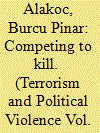

|
|
|
|
|
| Summary/Abstract |
Are organizationally linked suicide attacks deadlier than those launched by lone wolf terrorists? This article elaborates a perpetrator-based distinction among suicide terrorist attacks between organizations and lone wolf terrorists, who operate in the absence of a financially or physically supportive terrorist organization. The expectation is that terrorist organizations would serve as commitment tools that increase the loyalty of suicide bombers to their missions through material and non-material incentives. Findings demonstrate that when terrorist organizations are involved in the planning and execution of suicide terrorist attacks, not only do they increase the lethality of these attacks but they also accentuate the tactical advantages of suicide terrorism. These findings suggest that despite the recent upsurge and concern about lone wolf terrorism, the lethality and security impacts of suicide terrorism continue to be driven by terrorist organizations.
|
|
|
|
|
|
|
|
|
|
|
|
|
|
|
|
| 11 |
ID:
124142
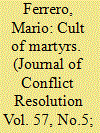

|
|
|
|
|
| Publication |
2013.
|
| Summary/Abstract |
This article suggests a rational explanation for extreme voluntary sacrifice in situations in which the state of the world when the decision must be made is observable only by the agent. Such explanation is the cult of martyrs, heroes, and saints. This cult may get out of control and fuel fanaticism, or excessive sacrifice from the standpoint of the sponsoring organization. A survey of the historical evidence of Christian martyrdom strongly suggests that martyrs were driven by the expectation of a cult in this world, not by otherworldly rewards. In particular, it is argued that the evidence of excess martyrdom in both Muslim Spain and the Roman Empire strongly speaks for the cult theory.
|
|
|
|
|
|
|
|
|
|
|
|
|
|
|
|
| 12 |
ID:
112390


|
|
|
|
|
| Publication |
2012.
|
| Summary/Abstract |
This paper provides a theoretical analysis of suicide attacks and defection. First, decision processes of potential attackers are examined from an economist's perspective. The results are then applied to insights from behavioural economics and psychology. We derive conditions under which agents decide to become suicide bombers-or to announce an attack and defect later. Taking account of hyperbolic discounting we show why the decision to commit a suicide attack can be time-inconsistent and what internal manipulation mechanisms (arising from cognitive dissonance and terror management) and external manipulation mechanisms (employed by terrorist organizations and governments) might prevent or foster time-inconsistency.
|
|
|
|
|
|
|
|
|
|
|
|
|
|
|
|
| 13 |
ID:
076885


|
|
|
|
|
| Publication |
2007.
|
| Summary/Abstract |
This article conducts quantitative tests on the relationship between regime type and suicide terrorism for 1980 to 2003. We present the recently popularized argument that democracies are more likely to experience suicide terrorism and a new hypothesis that mixed regimes are especially likely to experience suicide terrorism. We offer several improvements in research design, including using more controls, the nation-year as the unit of analysis, and more appropriate statistical techniques. Using both Freedom House and Polity data, we find that in general, regime type is uncorrelated with suicide terrorism. We do find that there is a statistically significant interaction between regime type and the number of religiously distinct minorities at risk (MARs) with suicide terrorism, but the statistical significance of this finding is limited, and its substantive impact is marginal. We also find that national size, Islam, national experience with suicide terrorism, and global experience with suicide terrorism affect the likelihood of suicide terrorism
|
|
|
|
|
|
|
|
|
|
|
|
|
|
|
|
| 14 |
ID:
065916
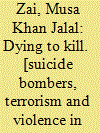

|
|
|
|
|
| Publication |
Lahore, Institute of Advance & Strategic Studies, 2005.
|
| Description |
174p.
|
|
|
|
|
|
|
|
|
|
|
|
Copies: C:1/I:0,R:0,Q:0
Circulation
| Accession# | Call# | Current Location | Status | Policy | Location |
| 050160 | 303.625/ZAI 050160 | Main | On Shelf | General | |
|
|
|
|
| 15 |
ID:
078086
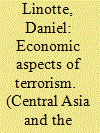

|
|
|
| 16 |
ID:
094738


|
|
|
|
|
| Publication |
2010.
|
| Summary/Abstract |
The literature on conflict and terrorism has paid little attention to the economic costs of terrorism for the perpetrators. This article aims to fill that gap by examining the economic costs of harboring suicide terror attacks. Using data covering the universe of Palestinian suicide terrorists during the second Palestinian uprising, combined with data from the Palestinian Labor Force Survey, the authors identify and quantify the impact of a successful attack on unemployment and wages. They find robust evidence that terror attacks have important economic costs. The results suggest that a successful attack causes an increase of 5.3 percent in unemployment, increases the likelihood that the district's average wages fall in the quarter following an attack by more than 20.0 percent, and reduces the number of Palestinians working in Israel by 6.7 percent relative to its mean. Importantly, these effects are persistent and last for at least six months after the attack.
|
|
|
|
|
|
|
|
|
|
|
|
|
|
|
|
| 17 |
ID:
080369


|
|
|
|
|
| Publication |
2007.
|
| Summary/Abstract |
Over the last few years, Moroccans have been disproportionately involved in jihadist terrorism. Morocco has been increasingly identified as one of the largest producers of terrorists and insurgents in Afghanistan, Iraq, and throughout Europe. This article examines the factors behind the emergence of jihadist terrorism in Morocco, and how this terrorist threat has gone beyond this country's borders. Three factors have contributed to this development: the influence of global jihad on potential Moroccan jihadists; the growing Islamization of the country; and deteriorating socioeconomic conditions. In analyzing these variables, special attention will be paid to the Casablanca terrorist attacks on May 16, 2003, marking the debut of suicide terrorism in Morocco. The article will also examine the principal counterterrorist initiatives Morocco has implemented in response to this threat.
|
|
|
|
|
|
|
|
|
|
|
|
|
|
|
|
| 18 |
ID:
148738
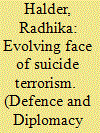

|
|
|
| 19 |
ID:
077001
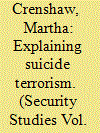

|
|
|
| 20 |
ID:
117902
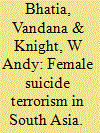

|
|
|
|
|
| Publication |
2011.
|
| Summary/Abstract |
In this article we compare two conflicts in South Asia-civil war in Sri Lanka and the insurgency in Kashmir-to investigate the enabling conditions for female suicide terrorism in the former, and the lack thereof in the latter. We conclude that female suicide terrorism is a product of several inter-related factors that feed into each other: (i) tormented society, (ii) individual grievances, and (iii) a terrorist organisation with an effective indoctrination structure. Thus, rather than focusing on the individual motivations behind the female bombers, it is important to situate them in specific socio-political contexts.
|
|
|
|
|
|
|
|
|
|
|
|
|
|
|
|
|
|
|
|
|